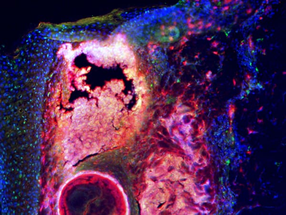Acne Breakthrough: Fat Cells in the Skin May Help Fight Acne

Fibroblasts produce cathelicidin in skin to help combat infection by suppressing bacteria that can cause acne.
New research suggests that fibroblasts outside of hair follicles play a larger role in acne development.
Fibroblasts produce an antimicrobial peptide called cathelicidin in skin. To counter an infection within a hair follicle, the surrounding skin undergoes a process called reactive adipogenesis in which fibroblasts transform into fat cells. Cathelicidin is produced to help combat the infection by suppressing bacteria that can cause acne.
The findings are published in the February 16, 2022, issue of Science Translational Medicine.
“We began our research wanting to understand the biology of acne and specifically looked at the role of fibroblasts, which typically provide structural support in the deeper layers of the skin,” says first author Alan O’Neill, PhD, project scientist at UC San Diego School of Medicine, in a news release. “What we uncovered instead was that these cells were activated to produce large amounts of an important antimicrobial, cathelicidin, in response to acne-causing bacteria called Cutibacterium acnes.”
The research team performed skin biopsies on acne patients treated for several months with retinoids, a class of chemicals derived from vitamin A found to promote skin health. To the researchers’ surprise, the drug enhanced cathelicidin expression after treatment, thus finding an additional, unknown mechanism for why retinoids help treat acne.
To support these findings, researchers studied skin lesions on mice injected with the acne-causing bacteria and observed similar treatment responses in the mice.
“These findings may transform the way we treat acne,” says Richard Gallo, MD, PhD, Ima Gigli Distinguished Professor of Dermatology and chair of the Department of Dermatology at UC San Diego School of Medicine. “Previously, it was thought that hair follicles were most important for acne to develop. In this study, we looked at the cells outside of the hair follicle and found they had a major effect on controlling bacteria and the development of acne.”
Cathelicidin being so highly expressed in acne biopsy tissue was a very interesting finding to us,” says Gallo. “Knowing this will be helpful in developing a more targeted therapy to treat acne.”
Currently, retinoid treatment focuses on controlling the development of lipids in skin cells. One major side effect of these drugs are their teratogenic effects, causing fetal abnormalities in pregnant people. This limits the use of these drugs to only severe cases. The research team hopes these findings may assist in developing a more targeted approach to treating acne.
“This research could assist in identifying new treatment options that specifically target the fibroblast’s ability to produce cathelicidin,” says O’Neill. “Thus creating a therapeutic for acne that would be more selective with potentially less harmful side effects.”
PHOTO CAPTION: MICROSCOPIC IMAGE OF AN INFLAMED PIMPLE WITH CATHELICIDIN STAINED RED, FAT CELLS STAINED GREEN AND THE NUCLEI OF EVERY CELL STAINED BLUE. BECAUSE CATHELICIDIN IS PRODUCED FROM FAT CELLS, THEIR STAINING MERGES TOGETHER.

Facebook Comments